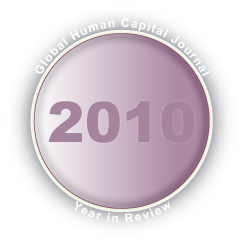 In Five Tips for Smarter Social Networking in their Big Shift Harvard Business Review blog, John Hagel III and John Seely Brown offer solid advice for executives who want to get traction with social networks, some of which might surprise you. It’s valuable for executives from individual and company perspectives. Here’s the post, and here’s my response, which builds and extends some of their points: In Five Tips for Smarter Social Networking in their Big Shift Harvard Business Review blog, John Hagel III and John Seely Brown offer solid advice for executives who want to get traction with social networks, some of which might surprise you. It’s valuable for executives from individual and company perspectives. Here’s the post, and here’s my response, which builds and extends some of their points:
John2, thanks for very solid advice all around. However, I totally agree with @cole, to be most productive as an individual or an enterprise, you must have an explicit strategy. An enterprise is an orchestra, so defining key goals and techniques, without dictating, is critical for success. This includes giving guidance and space for employees to pursue their personal branding, by resonating with the enterprise.
[…]
Web 3.0 and Social Business—2011 Predictions and Recommendations describes a turning point, away from social media to social business. SocialTech Grows Up—Relationship the Foundation of Business Success—Digital Clodhoppers Become Sore Thumbs.
 2011 will mark a turning point in the adoption of digital social technologies because the experimentation phase is drawing to a close, and stakeholder expectations are increasing. Organizations and people will no longer gain attention by executing badly. At the enterprise level, participation will wane in venues and initiatives that have no business strategy, focus, content strategy and commitment. Paying inexperienced people or agencies to “share” snappy content will expose brands as digital clodhoppers and push customers away. Individuals will also have to improve their game and focus on the most relevant people in their networks. Stop sending default invitations on LinkedIn. Proactively support people whom you respect and trust the most. The theme is determining and executing on strategy, focus and commitment. 2011 will mark a turning point in the adoption of digital social technologies because the experimentation phase is drawing to a close, and stakeholder expectations are increasing. Organizations and people will no longer gain attention by executing badly. At the enterprise level, participation will wane in venues and initiatives that have no business strategy, focus, content strategy and commitment. Paying inexperienced people or agencies to “share” snappy content will expose brands as digital clodhoppers and push customers away. Individuals will also have to improve their game and focus on the most relevant people in their networks. Stop sending default invitations on LinkedIn. Proactively support people whom you respect and trust the most. The theme is determining and executing on strategy, focus and commitment.
In 2011, the bar to attract and hold attention will be higher, which will present organizations with a new threat: when participation falls, some executives will conclude that […]
2010 Year In Review Initial Glimmers of Social Business is the Editor’s Choice of the Global Human Capital Journal—The Best Strategy, Tactics, Case Studies and Insights of 2010
 Compared to its progenitors 2009 and 2008, 2010 was a relatively calm year because the amplitude of market gyrations was clearly less, and businesses began to find a new floor on which to build stakeholder expectations. Although I watched with high interest the unfolding drama in Europe, I didn’t have the time to conduct the research necessary to do a rigorous interpretation. I did publish a reflection in January, which is not included in this year in review. However, 2010 marked a major turning point in the adoption of social technologies: the recognition that analysis and strategy were necessary to achieve consistent results with social initiatives. Compared to its progenitors 2009 and 2008, 2010 was a relatively calm year because the amplitude of market gyrations was clearly less, and businesses began to find a new floor on which to build stakeholder expectations. Although I watched with high interest the unfolding drama in Europe, I didn’t have the time to conduct the research necessary to do a rigorous interpretation. I did publish a reflection in January, which is not included in this year in review. However, 2010 marked a major turning point in the adoption of social technologies: the recognition that analysis and strategy were necessary to achieve consistent results with social initiatives.
2010 Macro trends
Social has been in adolescence up through 2009-2010 in which “being on Facebook” was an end in itself, agencies produced vapid content and little interaction happened because people won’t interact when brands are talking at them and not listening. People feel it when a […]
At first, it seemed that the machine had tilted, its levers, bells and flippers having hit some kind of glitch, causing us to lose the ball and the bonus points.
 As the curtain rises on the second decade of the twenty-first century, we will see that the machine is actually fine, but it’s become a different game. Quite entirely. To put it mildly, “the economy” is proving to be quite a drama, its pungence largely dependent on where your company or career is wired into it. Although it is quite frowned upon in the U.S. to admit despair, some pundits have even flirted with the moniker, “The Great Recession” to describe the crisis, a faint nod to the Great Depression of the 1930s, but this comparison is off-base. As I have argued for some time, the 2007-2010 “financial crisis” has played a mere overture to the real story, a transformation of the global “economic architecture.” I first heard this deft phrase from His Excellency Shri Kamal Nath, India’s very diplomatic Minister of Commerce in 2008 (coverage here). As the curtain rises on the second decade of the twenty-first century, we will see that the machine is actually fine, but it’s become a different game. Quite entirely. To put it mildly, “the economy” is proving to be quite a drama, its pungence largely dependent on where your company or career is wired into it. Although it is quite frowned upon in the U.S. to admit despair, some pundits have even flirted with the moniker, “The Great Recession” to describe the crisis, a faint nod to the Great Depression of the 1930s, but this comparison is off-base. As I have argued for some time, the 2007-2010 “financial crisis” has played a mere overture to the real story, a transformation of the global “economic architecture.” I first heard this deft phrase from His Excellency Shri Kamal Nath, India’s very diplomatic Minister of Commerce in 2008 (coverage here).
[…]
 In Allfacebook, Nick O’Neill presents a chart that compares the first six years’ revenue for Yahoo!, Google and Facebook. Even though some of these exercises are coffee-cooler talk without much substance, this one afforded the opportunity to think about how Facebook and Google add value. In Allfacebook, Nick O’Neill presents a chart that compares the first six years’ revenue for Yahoo!, Google and Facebook. Even though some of these exercises are coffee-cooler talk without much substance, this one afforded the opportunity to think about how Facebook and Google add value.
According to BusinessInsider’s interpretation, neither Google nor Facebook emphasized revenue in the early years and hockey-sticked later. Here’s the article, and here are my thoughts on all three players:
[…]
 Comparing Enterprise Social Media Consultants and Providers offers tools and processes to compare various types of social business, social media and social networking consultants. This came up this evening, when I responded to a question in one of my LinkedIn executive groups in which another member asked whether social media consulting was a “real business” for which market demand was real. I always appreciate these questions when they reflect a sincere desire to get a feeling for an emerging market space. Here is how I responded, plus additional details. Comparing Enterprise Social Media Consultants and Providers offers tools and processes to compare various types of social business, social media and social networking consultants. This came up this evening, when I responded to a question in one of my LinkedIn executive groups in which another member asked whether social media consulting was a “real business” for which market demand was real. I always appreciate these questions when they reflect a sincere desire to get a feeling for an emerging market space. Here is how I responded, plus additional details.
A Market for Social Media Services?
Depending on how one defines “social media,” it is already a multimillion dollar consulting and services industry. Most of the players have a marketing approach in which they help their clients to create content and interact with people in major platforms such as Facebook, Twitter, YouTube, LinkedIn, MySpace, blogs and specialized social networks. Most firms focus on consumer-facing (“B2C”) scenarios because the market for business to business use of social technologies significantly lags consumer uses. The three main types of social media services providers are:
[…]
 At the enterprise social business engagement Engaging Times Summit, Mike gave an overview of the Alterian software stack and a preview of their new platform. The key takeaway is that Alterian is not a social media company, its core competency is deep marketing data analysis. That said, their SM2 platform is one of the social media monitoring leaders [disclosure, I’m an SM2 client]. At the enterprise social business engagement Engaging Times Summit, Mike gave an overview of the Alterian software stack and a preview of their new platform. The key takeaway is that Alterian is not a social media company, its core competency is deep marketing data analysis. That said, their SM2 platform is one of the social media monitoring leaders [disclosure, I’m an SM2 client].
[…]
 Social Business Engagement Summit Panel: Brands at Risk featured: Donna Rossi, Vice President, Global Customer Experience Management, Western Union; Rob Singer, Senior Vice President, CRM, Bank of the West; Geoff Sherman, Director Pricing, Promotions & Trade Funds, Walgreens; Kathy Hecht, CMO, American Greetings Interactive; Michael Fisher, Senior Vice President, Alterian. Social Business Engagement Summit Panel: Brands at Risk featured: Donna Rossi, Vice President, Global Customer Experience Management, Western Union; Rob Singer, Senior Vice President, CRM, Bank of the West; Geoff Sherman, Director Pricing, Promotions & Trade Funds, Walgreens; Kathy Hecht, CMO, American Greetings Interactive; Michael Fisher, Senior Vice President, Alterian.
The message of this panel was that senior marketers and brands that don’t understand and embrace the changing landscape will feel the pain. Realize that the environment is changing fast:
[…]
 Social Business Engagement Summit Keynote Disruption Theme—Don Peppers keynoted the second day of Alterian’s 2010 User Conference, Engaging Times Summit with a talk entitled, “Death by word of Mouth.” Encouraging ,^) Social Business Engagement Summit Keynote Disruption Theme—Don Peppers keynoted the second day of Alterian’s 2010 User Conference, Engaging Times Summit with a talk entitled, “Death by word of Mouth.” Encouraging ,^)
Technology and interactivity are now. 96% of Gen Y are members of social networks. They are self-oriented and have no trust in adverts. He cited the film Bruno, which people panned in social networks and Twitter on its opening day; the box office fell 40% the next day (and never recovered). Before Web 2.0, the studio could have built momentum through adverts. No more. You can’t ungoogle yourself. […]
From a technology standpoint, social technologies merely digitize certain things that we already do when relating to one another socially. The rub is, most people aren’t terribly aware of how they relate to others or the process they go through when assessing others. This lack of awareness prevents them from using social technologies to create value. From time immortal, people have required periods of experimentation to “get” new technologies and to use them appropriately: flint, fire, gunpowder, electricity, Twitter… […]
|
|
 In Five Tips for Smarter Social Networking in their Big Shift Harvard Business Review blog, John Hagel III and John Seely Brown offer solid advice for executives who want to get traction with social networks, some of which might surprise you. It’s valuable for executives from individual and company perspectives. Here’s the post, and here’s my response, which builds and extends some of their points:
In Five Tips for Smarter Social Networking in their Big Shift Harvard Business Review blog, John Hagel III and John Seely Brown offer solid advice for executives who want to get traction with social networks, some of which might surprise you. It’s valuable for executives from individual and company perspectives. Here’s the post, and here’s my response, which builds and extends some of their points:
 2011 will mark a turning point in the adoption of digital social technologies because the experimentation phase is drawing to a close, and stakeholder expectations are increasing. Organizations and people will no longer gain attention by executing badly. At the enterprise level, participation will wane in venues and initiatives that have no business strategy, focus, content strategy and commitment. Paying inexperienced people or agencies to “share” snappy content will expose brands as digital clodhoppers and push customers away. Individuals will also have to improve their game and focus on the most relevant people in their networks. Stop sending default invitations on LinkedIn. Proactively support people whom you respect and trust the most. The theme is determining and executing on strategy, focus and commitment.
2011 will mark a turning point in the adoption of digital social technologies because the experimentation phase is drawing to a close, and stakeholder expectations are increasing. Organizations and people will no longer gain attention by executing badly. At the enterprise level, participation will wane in venues and initiatives that have no business strategy, focus, content strategy and commitment. Paying inexperienced people or agencies to “share” snappy content will expose brands as digital clodhoppers and push customers away. Individuals will also have to improve their game and focus on the most relevant people in their networks. Stop sending default invitations on LinkedIn. Proactively support people whom you respect and trust the most. The theme is determining and executing on strategy, focus and commitment. Compared to its progenitors 2009 and 2008, 2010 was a relatively calm year because the amplitude of market gyrations was clearly less, and businesses began to find a new floor on which to build stakeholder expectations. Although I watched with high interest the unfolding drama in Europe, I didn’t have the time to conduct the research necessary to do a rigorous interpretation. I did publish a reflection in January, which is not included in this year in review. However, 2010 marked a major turning point in the adoption of social technologies: the recognition that analysis and strategy were necessary to achieve consistent results with social initiatives.
Compared to its progenitors 2009 and 2008, 2010 was a relatively calm year because the amplitude of market gyrations was clearly less, and businesses began to find a new floor on which to build stakeholder expectations. Although I watched with high interest the unfolding drama in Europe, I didn’t have the time to conduct the research necessary to do a rigorous interpretation. I did publish a reflection in January, which is not included in this year in review. However, 2010 marked a major turning point in the adoption of social technologies: the recognition that analysis and strategy were necessary to achieve consistent results with social initiatives. As the curtain rises on the second decade of the twenty-first century, we will see that the machine is actually fine, but it’s become a different game. Quite entirely. To put it mildly, “the economy” is proving to be quite a drama, its pungence largely dependent on where your company or career is wired into it. Although it is quite frowned upon in the U.S. to admit despair, some pundits have even flirted with the moniker, “The Great Recession” to describe the crisis, a faint nod to the Great Depression of the 1930s, but this comparison is off-base. As I have argued for some time, the 2007-2010 “financial crisis” has played a mere overture to the real story, a transformation of the global “economic architecture.” I first heard this deft phrase from His Excellency Shri Kamal Nath, India’s very diplomatic Minister of Commerce in 2008 (coverage here).
As the curtain rises on the second decade of the twenty-first century, we will see that the machine is actually fine, but it’s become a different game. Quite entirely. To put it mildly, “the economy” is proving to be quite a drama, its pungence largely dependent on where your company or career is wired into it. Although it is quite frowned upon in the U.S. to admit despair, some pundits have even flirted with the moniker, “The Great Recession” to describe the crisis, a faint nod to the Great Depression of the 1930s, but this comparison is off-base. As I have argued for some time, the 2007-2010 “financial crisis” has played a mere overture to the real story, a transformation of the global “economic architecture.” I first heard this deft phrase from His Excellency Shri Kamal Nath, India’s very diplomatic Minister of Commerce in 2008 (coverage here). Comparing Enterprise Social Media Consultants and Providers offers tools and processes to compare various types of social business, social media and social networking consultants. This came up this evening, when I responded to a question in one of my LinkedIn executive groups in which another member asked whether social media consulting was a “real business” for which market demand was real. I always appreciate these questions when they reflect a sincere desire to get a feeling for an emerging market space. Here is how I responded, plus additional details.
Comparing Enterprise Social Media Consultants and Providers offers tools and processes to compare various types of social business, social media and social networking consultants. This came up this evening, when I responded to a question in one of my LinkedIn executive groups in which another member asked whether social media consulting was a “real business” for which market demand was real. I always appreciate these questions when they reflect a sincere desire to get a feeling for an emerging market space. Here is how I responded, plus additional details. Social Business Engagement Summit Panel: Brands at Risk featured: Donna Rossi, Vice President, Global Customer Experience Management, Western Union; Rob Singer, Senior Vice President, CRM, Bank of the West; Geoff Sherman, Director Pricing, Promotions & Trade Funds, Walgreens; Kathy Hecht, CMO, American Greetings Interactive; Michael Fisher, Senior Vice President, Alterian.
Social Business Engagement Summit Panel: Brands at Risk featured: Donna Rossi, Vice President, Global Customer Experience Management, Western Union; Rob Singer, Senior Vice President, CRM, Bank of the West; Geoff Sherman, Director Pricing, Promotions & Trade Funds, Walgreens; Kathy Hecht, CMO, American Greetings Interactive; Michael Fisher, Senior Vice President, Alterian. Social Business Engagement Summit Keynote Disruption Theme—Don Peppers keynoted the second day of Alterian’s 2010 User Conference, Engaging Times Summit with a talk entitled, “Death by word of Mouth.” Encouraging ,^)
Social Business Engagement Summit Keynote Disruption Theme—Don Peppers keynoted the second day of Alterian’s 2010 User Conference, Engaging Times Summit with a talk entitled, “Death by word of Mouth.” Encouraging ,^)